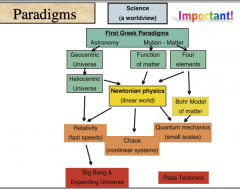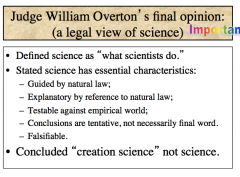![]()
![]()
![]()
Use LEFT and RIGHT arrow keys to navigate between flashcards;
Use UP and DOWN arrow keys to flip the card;
H to show hint;
A reads text to speech;
33 Cards in this Set
- Front
- Back
|
nebular hypothesis |
is the most widely accepted model in the field of cosmogony to explain the formation and evolution of the Solar System. It suggests that the Solar System formed from nebulous material |
|
|
Supernova / Black Holes Limits (compared to our sun) |
• 2-8 * Sun’s mass: Type 1 supernova (trigger runaway nuclear reaction, often by adding |
|
|
Evidence for black holes: |
Regions where size and speed of rotation tells us that huge masses |
|
|
Quasars |
We now think that these objects are probably mega-Black Holes, |
|
|
Virtual Particles |
We believe that information about the four |
|
|
Dark Matter - I |
The amount of lensing visible cannot |
|
|
‘Spacecraft Behaving Badly’ |
Pioneer 10 and Pioneer 11 are spacecraft that were |
|
|
Dark Energy |
• Dark energy is presumed to be a form of energy |
|
|
What is the universe made of? |
4% normal matter, 21% dark matter 74% dark energy |
|
|
What is the core problem with the astronomy paradigm? |
Another way to say this is need to combine 4 |
|
|
What is the mathematical field of Chaos theory? |
Dynamical Systems |
|
|
Broad definition of Chaos: |
A field of study in mathematics, physics, and |
|
|
Discreteness |
Most processes acting in the world today are continuous |
|
|
Nonlinearly? |
Nonlinearly in mathematics means that future values of |
|
|
How did Lorentz study chaotic systems? |
Weather models |
|
|
What is the main problem with dynamical systems? |
Problem is that very small changes in input |
|
|
Argue: Simple systems behave in simple ways |
No, simple systems may evolve into |
|
|
Argue: Complex behavior implies complex causes |
No, complex systems have underlying |
|
|
Argue: Different systems behave differently |
No, there is a shared universality of chaotic |
|
|
What is an attractor? |
An attractor is a set to which a |
|
|
Who studied variability? |
Benoit Mandelbrot 1924 |
|
|
What are the two patterns of variability? |
» spatial patterns - length of coastlines (example later) |
|
|
Self-Similarity: |
It has a fine structure at arbitrarily small scales. |
|
|
Examples of fluid flow: |
EXAMPLES: |
|
|
Benoit's two effects which are not accountable with linear systems analysis: |
» Noah effect = sudden discontinuous changes can occur |
|
|
What is science? |
• Model of Universe: A unified group of theories that |
|
|
Components of science? |
The universe Imperfect model of universe Doing science Imperfect scientists |
|
|
Paradigm shift? Who? |
Thomas Kuhn 1962 |
|
|
Explain paradigms of science: |

|
|
|
What does the timeline look like for those paradigms? |

|
|
|
Evidence for Great Flood: |
• Evidence for Black Sea
----- •Ice sheet melts fills lake. |
|
|
When did science become legally outlined? |

|
|
|
Normal star evolution: |
Normal Stars: |

